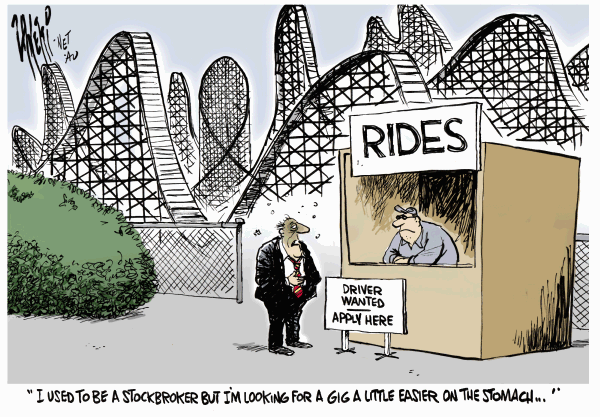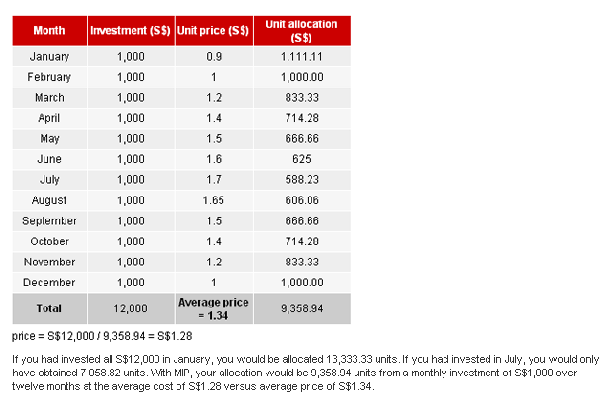01.20.2010
06.08.2014 Format update. ETF risk disclaimer update.
Buy? Sell? Run or Hide? What To Do this Year May be a Lot Like What You Should Do Every Year: Dollar Cost Averaging
A simple strategy on how to manage volatile markets over long periods of time such as for retirement planning.
Investor Education Series written by Net Advisor™
For over two decades 1000’s of people have asked me: “Is the (stock) market going to move higher or lower?”
My answer is almost always, “Yes.”
If I could tell you exactly when the market moves and in what direction to the minuet, my name would be Warren Buffet or John Paulson.
If one is worried or was overly concerned that you could experience a loss from investing, then the stock market may not the place for you, UNLESS you have:
1. Time on your side.
2. Have a sound Dollar Cost Averaging Plan in place with automatic regular investing.
Keep in mind that even the Pro’s get it wrong, but they keep going. They don’t give up.
“Hedge fund manager Kenneth Griffin’s Citadel Investment Group lost $8 billion in clients’ money last year, but is turning things around as markets recover and has made $5 billion in profits so far this year…”
— Source: Reuters
Sometimes they bet on failure and make money:
Sometimes they bet that total failure is not likely:
I remember people were asking me in the late 1990’s “when is this run (in the .com market) going to end?”
My answer was: Watch rising interest rates. Interest rates were rising from 1999-2000, so I became more and more cautious. I also noted that fewer stocks were moving the market higher in 1998-1999. By the third week of 2000, I saw NASDAQ break its trend line and told clients to, “SELL!”
Funny, NO ONE was asking me about how the housing market was peaking in spring 2006, and for a guy who is not a designated real estate expert; I saw a very similar pattern in that market as I did the .com market: Rising interest rates. Interest rates were rising from 2004-2006, so I became more and more cautious. By 2007 I was shocked that, how comes the stock market doesn’t see the housing market about to fall apart?
In short, two of Bear Sterns giant sub-prime hedge funds blew up (crashed) in spring 2007 and that was the final red flag I needed to see. In the fall of 2007 I posted several major warnings about the economy, interest rates, and housing. I saw banks tightening credit, and sent letters to the major banks warning them what would likely happen if they tightened credit (massive defaults and bankruptcies). I offered help in managing this risk. No bank responded to the offer.
The movie Wall Street (1987) reminded me of this situation:
“What the hell is Cromwell doin’ givin’ a lecture tour when he’s losing 60 million a quarter? Guess he’s giving lectures on how to lose money….”
— Wall Street, (Movie by Oliver Stone, 1987)
So what is the point to all this?
1. It can take years for a recession, or deep retracement to occur. The environment has to be a certain way to make the market move higher or lower. It took a year and change for the stock market to tank after rate increases from June 1999 to 2000. It took 2 years for the stock market (and real estate market) to tank after rate increases from 2004 to 2006.
2. We’ve had numerous recessions, multiple market crashes over the last 200 years, and guess what? The stock market is still around, and people still put money in it. And even though the media can seem to scare the crap out of you everyday about the bad news of the day that happened, the market has trended higher since day 1.
If you ask me will we see a “crash” again in our lifetime? Possibly; a deep correction? Mostly likely; a recession? Guaranteed… when I could not begin to guess. Technically speaking, the U.S. stock market has not an officially “Crashed” since 1987.
I argue this definition should be more broadly defined after watching the market tank in a what I call a sliding crash from March 2000 to October 2002, then again from Summer 2007 to March 2009.
When I hear people asking me that they want to wait and “buy at the bottom” I bring my sense of humor to the table. I say something such as, “OK, when is that going to happen, because that is when I would like to buy too.”
The typical first answer I get is typically a moment of silence. They are puzzled because they really don’t know when the bottom is, and neither does anyone else. Maybe with 100’s of guesses a couple people on the planet call the exact bottom, and people have been calling the 2007-2009 bottom for over 2 years.
I suggest to people that they need a good investment plan.
I have tried to help answer over 5,000 questions since 2007 on Yahoo! Answers. In most of my processional years, I have advocated that part of one’s investment strategy to include a dollar cost averaging plan. This is especially useful when you are younger say up to 50’s or so because you are not retiring for 15+ years in many cases. Then even if you do retire in 15+ years, you are not going to sell all your investments on retirement date because you are likely to live 20-30+ years longer.
Sample questions where I discuss in part, dollar cost averaging further:
How can I start buying stock online if I don’t have 500 dollars to put into the account?
I want to buy $10,000 worth of stock and plan to let it sit there until the economy is better?
What do I dollar cost average in?
This is where a professional personal advisor can help. It’s difficult to just say just buy x, y or z, because people have different goals, risk tolerance and time frames.
My general idea to consider has been this:
1. Open Roth IRA.
2. Choose a S&P 500 Index Fund such as from Vanguard or Fidelity, or whoever offers a lower cost S&P index fund with automatic monthly investing. Look at total costs to be in the fund such as management fees and including 12B-1 fees.
3. Set up the account to take whatever you can afford into the fund using an automatic monthly debit from a checking or savings account. I generally tell people (depending on overall situation, age, etc) to consider at least 10% of gross monthly income.
4. Dollar Cost Average (each month or bi-monthly if possible) into the S&P 500. Set it up to “reinvest all dividends and capital gains.” This last part is especially important, and makes a huge difference in your long-term returns. It’s free money, reinvest it. Read more PDF from S&P.)
5. Wait 30+ years (or at least 20+). Increase your contributions as your income picture changes. If you had to, you can get the PRINCIPLE out in 5 years in a Roth IRA. The profits must stay until retirement. After retirement gains in a Roth IRA may be withdrawn tax free.
Now, this is kind of a side bar issue, but for those who want to add some risk and high volatility in the short run, but trade off for a possible longer term gains, one may want to ALSO dollar cost average in funds or ETFs that investment in the following:
1. China
2. India
3. Brazil
Normally Russia would be in here at #4 (also called the “BRIC” counties), but in my view the above 3 may be better unless Russia decides to become more free market like the USA. If that happens, I’d add Russia. If they stay the same, I’m not too excited about that market as much. If I had to chose one I’d choose China.
*2014 UPDATE: The ETFs mentioned may have been better applied to 2010, and may not hold the same value or risk in 2014. These are not recommendations and should be reviewed for today’s suitability and risk. The concept of dollar-cost-average in major indexes such as the S&P 500, the DJIA and NASDAQ stands.
Please check with your investment advisor and medical doctor to see if you can stand the stress of volatility before engaging in these markets. Also, I would keep a time frame of 20-40 years for these markets. If your time frame is 5 years or less, the volatility and risk one is taking escalates dramatically.
If I had to pick one, it would be China. Why China”: Read my 01.13.2010 China report. I do think that China could have some short term correction issues but this is where dollar cost average can help. I still would dollar cost average in the S&P 500 Index with a 15-20 year minimum time frame in mind.
— Chart Source: HSBC.com
How Dollar Cost Averaging Can Help
Using a fixed dollar amount automatically taken out of a checking or savings account on one or two days per month, one will buy more shares when the market is down and buy fewer shares when the market is up.
This strategy works best in a fund or index.
Dollar Cost Averaging can work with stocks, but you better not be in a stock that has current bankruptcy risk, or a stock that has already moved 100+ percent in a short period of time (say last the 12 months) based on speculation (such as the .com market by late 1999).
For most people, index funds are the simpler non-emotional way for investing. If you have financial capital for long term investing (say over $100+k) one should talk to an advisor with preferable 15+ years of market experience, not just financial planning experience. It would not be a bad idea to talk to a financial professional (not the neighbor, the day trader, or other person at work or the beauty shop. If you have less funds available, don’t know what you are doing, or just don’t want to do the work, get the help you need.
A lot of people like to do this on their own, and many can do this. However, in my experience working with investors, not getting the right help from the beginning can be more costly later on.
Cartoon copyright by their respective owner
Original article content, Copyright © 2010, 2014 NetAdvisor.org® All Rights Reserved.
NetAdvisor.org® is a non-profit organization providing public education and analysis primarily on the U.S. financial markets, personal finance and analysis with a transparent look into U.S. public policy. We also perform and report on financial investigations to help protect the public interest. Read More.



